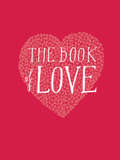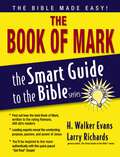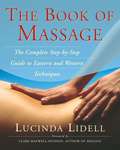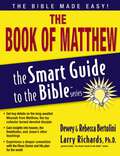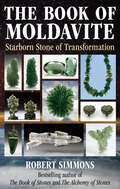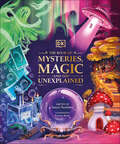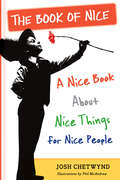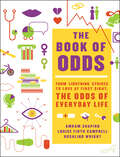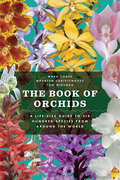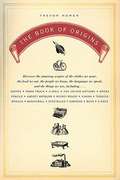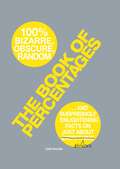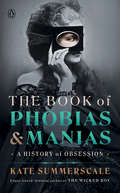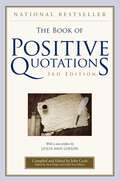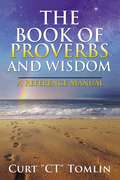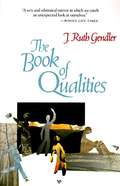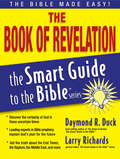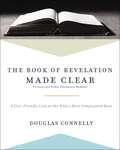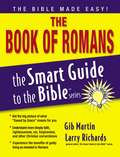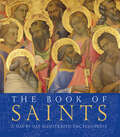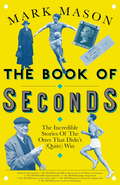- Table View
- List View
The Book of Love
by K.C. JonesThis luxe little book is the perfect gift for anyone in love or looking for love. A miscellany of all things love, it covers everything from charms and aphrodisiacs to tips on how to stay in love forever. Readers can look up their astrological love match and learn to use terms of endearment in different languages, like "mon petit chou" French for "my little cabbage." Also featured are recipes, potions, poems, quotes, famous couples, and romantic date and gift ideas. With a gorgeous textured cover, silkscreen edges, and a ribbon marker, The Book of Love is a sweet keepsake package for lovers everywhere.
The Book of Luke
by Dr Joyce GibsonDiscover What a Friend You Have in JesusHe's the Savior of the world, the Friend who stands by the sick and brokenhearted. He was perfectly human-and perfectly holy. He heals. He empowers. All this and more is uniquely captured in Luke's New Testament Gospel. The Smart Guide to the Bible: The Book of Luke reveals the good doctor's detailed research into Jesus' life and ministry (resulting in the longest of the four Gospels and the only one to have certain parables, like the Prodigal Son). You will be encouraged and emboldened, just as the early Christians were!Be Smart About:,Jesus' Humanity & DivinityJesus' Birth & DeathHealing & MiraclesTemptationJesus, Friend of SinnersRelating to PeopleJesus's MinistryAnd More! Smart Guides Are for Everyone!The Bible is loaded with valuable insights for every area of your life. The Smart Guides to the Bible let you easily uncover them all-even the passages you once thought were hard to understand.Whether you're new to the Bible, a long-time student of Scripture or somewhere in between, you'll appreciate the many ways the relevant helps on each page lead you to get the most out of God's Word.
The Book of Mark (The Smart Guide to the Bible Series)
by Walker EvansMark told it like it was so you could see Jesus as He is. Each Gospel, or biography of Jesus, is unique. The bold Book of Mark was written to the ruling Romans. This fast-paced narrative is the shortest Gospel. Likely penned first, Mark takes you into the action and gets to the point. Now, with the verse-by-verse insights of The Smart Guide to the BibleTM: The Book of Mark you'll experience the unparalleled power of Jesus and be inspired to live with greater authenticity and purpose.
The Book of Massage
by Lucinda LiddellExperience the Healing Power of Massage With more than 650,000 copies sold, The Book of Massage is the classic guide to the relaxing and healing skills of the hands. Featuring both Eastern and Western methods, it presents step-by-step, beautifully illustrated instructions on everything from traditional massage to shiatsu and reflexology. The Book of Massage offers easy-to-follow techniques for giving the perfect massage, including advice on creating the right setting and suggestions for using aromatic oils and lotions. In the comfort of your own home, you can Soothe away stress and tension Develop your body's unique healing powers Banish headaches and back pain Share the language of touch Experience optimum health and vitality Now revised and updated with fresh color photos and drawings throughout, The Book of Massage is a simple and comprehensive handbook that reveals how you can experience the myriad benefits of giving and receiving a soothing massage.
The Book of Matthew (The Smart Guide to the Bible Series)
by Dewey BertoliniThis First New Testament Book Gives You an Up-Close Look at the Savior of the WorldWhat did the arrival of the promised Messiah mean for the Jews of Matthew's day? What does it mean for you today? The Smart Guide to the Bible: The Book of Matthew gives you valuable insights into Christ's life and teachings, death, and resurrection so you can more fully experience the purpose and power of King Jesus at work in your life.Be Smart About Christ's Birth & Death Heaven The Beatitudes Prophecy O. T. Salvation Legalism The Future And More!
The Book of Moldavite: Starborn Stone of Transformation
by Robert SimmonsA full-color guide to the history, science, and spiritual uses of Moldavite• Shares the author&’s transformational discovery of the magic of Moldavite• Looks at Moldavite energy tools, how to combine Moldavite with other gemstones, and how to use Moldavite to transmit healing energy to people and places• Includes powerful Moldavite meditations and hundreds of photos, allowing you to attune to Moldavite&’s energy without even being in its direct presenceCreated from the cataclysmic impact of a huge meteorite, Moldavite is a gemstone that is neither heavenly nor earthly but something new that emerged from their union. Classed scientifically with tektites, these rare green celestial objects showered down over what is now the Czech Republic some 14.8 million years ago. In the mid-1980s, a series of synchronicities brought Moldavite into the hands of Robert Simmons, and he began sharing its powerful effects with the world. In this full-color guide, Simmons tells the story of his discovery of Moldavite&’s magic, weaving his knowledge of the stone&’s spiritual qualities together with scientific and historical data as well as channeled information. He explains how Neolithic peoples in Europe made Moldavite amulets and tools and how several Moldavite amulets were discovered in the same archaeological dig as the famous Venus of Willendorf, the earliest known Goddess figurine. The author describes his dramatic personal awakening and the surprising circumstances that brought Moldavite to the center of his life and career. He shares tales of crop circles and energy vortexes, his adventures in Moldavite country, and ET connections. Revealing how the science of Moldavite&’s origins resonates with ancient mystical legends, the author explores Moldavite&’s connections with the alchemical Emerald Tablet and the fabled Stone of the Holy Grail. He looks at Moldavite energy tools, including wands, pendulums, waters, essences, body layouts, and crystal grids. He explains how to use Moldavite in photonic layouts to transmit energy to people, places, and bodies of water in order to heal and revitalize them. He leads the reader through Moldavite meditations for expanding awareness, and his wife, Kathy, offers her insights into Moldavite&’s purpose and power and how we can align with it. Throughout the book are hundreds of full-color images of beautiful raw pieces, carvings, jewelry, and gems, allowing you to attune to Moldavite&’s energy without even being in its direct presence. Shining a light upon the starborn gem that unites spirit and matter, the author shows how Moldavite is—literally and figuratively—a joining of Heaven and Earth.
The Book of Mysteries, Magic, and the Unexplained (Mysteries, Magic and Myth)
by Tamara MacfarlaneA fascinating look into the secrets of the supernatural world for curious children obsessed with magic and mystery. Featuring bright and bold illustrations, Mysteries, Magic, and the Unexplained traces the story of myth and magic from ancient superstitions to medieval alchemy and divination to the modern-day fascination with UFOs. This book for children aged 7-9 explores every aspect of magic through the ages and across many cultures. It traces the history of magic ritual from spells and potions to alchemy and divination, as well as investigating other mysteries of the paranormal. While it&’s a fun read, it takes its subject seriously – taking a historical approach to the supernatural world across all cultures.This book about magic for children aged 7-9 offers:- Beautifully illustrated, imaginative and informative reference pages on wizards, witches, ghosts, cryptids, and other supernatural beings.- A look into UFOs and Extraterrestrials with possible explanations.- An explanation of the origins of festivals, rituals, from the history of Halloween and China&’s Hungry Ghost Festival to Mexico&’s Day of the Dead.- Special features on famous mysteries that were actually hoaxes.This compendium for kids of all things magical and unexplained throughout the ages will capture the imagination of kids everywhere. Taking a neutral stance, it explores the facts behind spells, seances and tarot cards, fortune tellers, witchcraft and wizardry, unexplained natural phenomena, and more.
The Book of Nice: A Nice Book About Nice Things for Nice People
by Josh ChetwyndNice is the secret ingredient to a better life. It makes us happy. It may even be what makes us civilized—when we say thank you, shake hands, send flowers, we’re doing the nice things that bring people together.?A compulsive and chunky book for lovers of trivia, popular history, customs, and culture—and a perfect gift to say “you’re nice”—The Book of Nice is an entertaining, quirky compendium of those signs, traditions, and expressions that we so often take for granted, yet turn out to be quite fascinating. It’s about why we cover a yawn (originally to prevent evil spirits from entering our bodies, now to hide the impression that something’s boring us). About holiday traditions—it’s thanks to Guy Lombardo’s December 31 broadcast in 1929 that we now sing “Auld Lang Syne” on New Year’s Eve. About customary offerings—the wedding cake evolved out of the Roman use of wheat as a symbol of fertility (and it’s much tastier than bits of grain). And about those simple yet essential niceties—how Thomas Edison championed an obscure term, “hello” (if Alexander Graham Bell had gotten his way, we’d all be saying “ahoy”). Why not put a little nice in your day?
The Book of Odds: From Lightning Strikes to Love at First Sight, the Odds of Everyday Life
by Amram Shapiro Louise Firth Campbell Rosalind WrightFrom the popular Book of Odds website, this stylish and accessible reference book offers a fascinating peek at the probabilities that govern every aspect of human lifeDid you know that your odds of dying from drowning are higher than the odds of meeting your mate on a blind date? That the odds a child has seen Internet porn are the same as the odds a person is right-handed? That nearly one in three adults believes in UFOs and nearly one in six has reported seeing one?Drawing from a rigorously researched trove of more than 400,000 statements of probability, based on the most accurate and current data available, The Book of Odds is a graphic reference source for stats on the everyday, the odd, and the outrageous—from sex and marriage, health and disease, beliefs and fears, to wealth, addiction, entertainment, and civic life. What emerges from this colorful and captivating volume is a rich portrait of who we are and how we live today.
The Book of Orchids: A Life-Size Guide to Six Hundred Species from Around the World
by Tom Mirenda Mark Chase Maarten Christenhusz“Clear, informative text. It is a superb production, reminding us of the astonishing diversity of these plants.” —Times Literary SupplementOne in every seven flowering plants on earth is an orchid. Yet orchids retain an air of exotic mystery—and they remain remarkably misunderstood and underappreciated. The orchid family contains an astonishing array of colors, forms, and smells that captivate growers from all walks of life across the globe. Though undeniably elegant, the popular moth orchid—a grocery store standard—is a bland stand-in when compared with its thousands of more complex and fascinating brethren, such as the Demon Queller, which grows in dark forests where its lovely blooms are believed to chase evil forces away. Or the Fetid Sun-God, an orchid that lures female flies to lay their eggs on its flowers by emitting a scent of rancid cheese.The Book of Orchids revels in the diversity and oddity of these beguiling plants. Six hundred of the world’s most intriguing orchids are displayed, along with life-size photographs that capture botanical detail, as well as information about distribution, peak flowering period, and each species’ unique attributes, both natural and cultural. With over 28,000 known species, the orchid family is the largest and most geographically widespread of the flowering plant families. Including the most up-to-date science and accessibly written by botanists Mark Chase, Maarten Christenhusz, and Tom Mirenda, each entry in The Book of Orchids will entice researchers and orchid enthusiasts alike.“A luscious coffee-table tome.” —Nature
The Book of Origins: Discover the Amazing Origins of the Clothes We Wear, the Food We Eat, the People We Know, the Languages We Speak, and the Things We Use
by Trevor HomerEverything—from the mundane (the pencil) to the catastrophic (the atom bomb)—has an origin, but often it&’s not what we expect. A few things you may not have known: • Gandhi was married at age thirteen! • Chinese fortune cookies are an American invention and were not eaten in China until the 1990s when they were advertised as &“Genuine American Fortune Cookies.&” • Bayer lost the trademark for aspirin (which they had held since 1897) as part of the reparations Germany was forced to pay after World War I. • The original idea for the electric chair came from an American dentist. For aspiring mindblowers and wanna-be know-it-alls, The Book of Origins is a treasure trove of trivia and fascinating facts guaranteed to entertain and enlighten.
The Book of Percentages
by Tom PhilbinYou will now be able to wow your friends, scare your kids, and bargain with your spouse as you use this book to legitimize bad decisions, idle threats, and risky ventures. With this one-stop statistical resource, you will have plenty of numbers to back up whatever you want (or don't want) to do. Covering all aspects of everyday life, this enlightening little trivia book shows you that numbers can be informative yet entertaining'and work to your advantage. Inside you will learn interesting tidbits like: While 30% of all shoplifters are under thirty, 95% of shoplifters are females'just another thing for teenage boys to throw in their parents? faces Ditching a diet is the fad thing to do, as 60% of dieters fail and go back to eating fatty foods Finding a faithful contractor is much easier than finding a faithful husband: Only 10% of home improvement contractors are reported larcenous while 22% of married men have committed adultery The world would have a whole lot more female vegetarians if people had to kill their dinner?90% of women would give up beef if they had to kill the cow Americans have a 40% chance of just dropping dead every day It's a guaranteed enlightening read 100% of the time.
The Book of Percentages
by Tom PhilbinYou will now be able to wow your friends, scare your kids, and bargain with your spouse as you use this book to legitimize bad decisions, idle threats, and risky ventures. With this one-stop statistical resource, you will have plenty of numbers to back up whatever you want (or don't want) to do. Covering all aspects of everyday life, this enlightening little trivia book shows you that numbers can be informative yet entertaining--and work to your advantage. Inside you will learn interesting tidbits like:While 30% of all shoplifters are under thirty, 95% of shoplifters are females--just another thing for teenage boys to throw in their parents' facesDitching a diet is the fad thing to do, as 60% of dieters fail and go back to eating fatty foodsFinding a faithful contractor is much easier than finding a faithful husband: Only 10% of home improvement contractors are reported larcenous while 22% of married men have committed adulteryThe world would have a whole lot more female vegetarians if people had to kill their dinner--90% of women would give up beef if they had to kill the cowAmericans have a 40% chance of just dropping dead every dayIt's a guaranteed enlightening read 100% of the time.
The Book of Percentages: Over 500 bizarre, obscure, random, surprising, and 100% enlightening facts on just about everything nothing
by Tom PhilbinYou will now be able to wow your friends, scare your kids, and bargain with your spouse as you use this book to legitimize bad decisions, idle threats, and risky ventures. With this one-stop statistical resource, you will have plenty of numbers to back up whatever you want (or don’t want) to do. Covering all aspects of everyday life, this enlightening little trivia book shows you that numbers can be informative yet entertaining—and work to your advantage. Inside you will learn interesting tidbits like:While 30% of all shoplifters are under thirty, 95% of shoplifters are females—just another thing for teenage boys to throw in their parents’ facesDitching a diet is the fad thing to do, as 60% of dieters fail and go back to eating fatty foodsFinding a faithful contractor is much easier than finding a faithful husband: Only 10% of home improvement contractors are reported larcenous while 22% of married men have committed adulteryThe world would have a whole lot more female vegetarians if people had to kill their dinner—90% of women would give up beef if they had to kill the cowAmericans have a 40% chance of just dropping dead every dayIt’s a guaranteed enlightening read 100% of the time.
The Book of Pet Love and Loss: Words of Comfort and Wisdom from Remarkable People
by Sara BaderA powerful collection of quotations by writers, leaders, and legends on the pain of losing a pet and overcoming grief.An animal&’s love is deep, uncomplicated, unconditional, and forgiving. &“Affection without ambivalence&” is how Sigmund Freud described the connection. &“No matter how awful the day, or how awful I am behaving at any given moment, George doesn&’t care,&” writes journalist John Dickerson. &“He finds me smoldering in my chair and dashes to my lap.&” Our lives are intricately intertwined with our pets, and together, over time, we establish rituals that are as steady as a metronome. It&’s no wonder the grief is crushing when they depart—even those who&’ve had time to prepare describe feeling stunned, devastated, and cracked in two. &“We were a bit broken up over the death of our black Persian cat,&” crime novelist Raymond Chandler confessed. &“When I say a bit broken up, I am being conventional. For us it was a tragedy.&” Nobel Prize–winning author V. S. Naipaul described the experience as &“calamitous,&” and writer May Sarton called it a &“volcanic eruption of woe.&” Poet Emily Dickinson was so bereft she asked for help: &“Carlo died,&” she announced in a letter to her friend Thomas Wentworth Higginson in 1866. &“Would you instruct me now?&” The Book of Pet Love and Loss is a collection of quotations—poignant thoughts and memories discovered in letters, journals, diaries, memoirs, and other original sources—from beloved cultural figures who understood this singular experience so deeply, they felt compelled to write about it. This book dignifies the profound connection we share with our animal companions, but it also provides solace as mourners document their heartache over the loss of their cats, dogs, rabbits, birds, and other animals—even, in the case of Pablo Neruda, a mongoose. Their comforting and wise words are what every animal lover needs on this journey of heartbreak and healing.
The Book of Phobias and Manias: A History of Obsession
by Kate SummerscaleFrom the winner of the Edgar Award and the Samuel Johnson Prize, a cultural history of &“everyday madness&”The Book of Phobias and Manias is a thrilling compendium of 99 obsessions that have shaped us all, the rare and the familiar, from ablutophobia (a horror of washing) to syllogomania (a compulsion to hoard) to zoophobia (a fear of animals). Phobias and manias are deeply personal experiences, and among the most common anxiety disorders of our time, but they are also clues to our shared past. The award-winning author Kate Summerscale uses rich and riveting case studies to trace the origins of our obsessions, unearthing a history of human strangeness, from the middle ages to the present day, and a wealth of explanations for some of our most powerful aversions and desires.
The Book of Positive Quotations
by John CookWith more than 10,000 entries on 62 subjects, The Book of Positive Quotations is an invaluable tool for writers, public speakers, coaches, business leaders—anyone who needs to communicate a positive message to an audience. It is conveniently organized by subject and thoroughly indexed for ease of use. Includes a new Preface by contributor Leslie Ann Gibson.&“Every now and then, each of us can use some words of inspiration, messages that motivate. John Cook happily provides them in this book.&”—Gannett News Service
The Book of Proverbs and Wisdom: A Reference Manual
by Curt TomlinThe author of The Book of Proverbs and Wisdom, A Reference Manual, Curt &“CT&” Tomlin, was inspired by the Holy Spirit to write &“The Book&” to enhance and illuminate Christian understanding of the Old Testament&’s Book of Proverbs.The author received instructions from the Holy Spirit to write an 'illuminated', The Book of Proverbs and Wisdom, A Reference Manual, whereby every Proverbs verse, would be positioned and contained, in one or more Chapter Theme(s); Accordingly, each Chapter Theme(s), characterizes and reflects, the various Proverbs verses listed and/or contained in the Biblical 'Book of Proverbs'; Thus, every Proverbs verse(s), phrase and/or series of Proverbs verses, has been positioned into one or more of the 70 Chapters contained in &“The Book&”. Additionally, as it is more often the case, that a specific Proverbs verse, might be listed within multiple Chapter Themes! For example, one of my all-time favorite Proverbs verses is Proverbs 1:7, which states--"The fear of the LORD is the beginning of knowledge, But fools despise wisdom and instruction". Accordingly, you will find this Proverbs verse listed in six different Chapter Themes, namely: (a) 'Fear of the LORD'; (b) 'Knowledge'; (c) 'Fools/Foolishness'; (d) 'Hate/Despise'; (e) 'Wisdom'; and (f) 'Instruction', based on the 'key word(s)' listed above. Additionally, I have used, the NKJV version of the Bible, including this version&’s citations; Punctuations; Fonts and Appropriateness for Inclusion, for said Chapter Theme.Within &“The Book&”, each Proverbs verse is included or assigned to a specific Chapter Theme, based on such key word(s), phrase(s) or overall Chapter Theme associated with such Proverbs verse. For example: Where there is a direct, one-on-one tie in to a Chapter Theme from a Proverbs verse, then such key word has been, bolded, underscored, and italicized.Additionally, The Book of Proverbs and Wisdom, A Reference Manual, contains the author's notations to most of the Biblical Proverbs verses, such that the following author's notations are specified: For many Biblical Proverbs verses, the author assigned a: One (*); Two (**); or Three (***) notation for that Proverbs verse, and such a rating, from his perspective, represents how that Proverbs verse, spoke to his heart, i.e. "Good*", "Better**", or "Best***". Uniquely, ALL category Three (***) Proverbs verse notations, have been "Bolded", where such Proverbs verse appears within The Book of Proverbs and Wisdom, A Reference Manual. For example, Proverbs 1:7--"The fear of the LORD is the beginning of knowledge, But fools despise wisdom and instruction", appears in the already mentioned Chapter Themes in a 'bold' fashion.Another unique characteristic of The Book of Proverbs and Wisdom, A Reference Manual, is that, on numerous occasions within a particular Chapter Theme, the author includes surrounding Proverbs verse(s) within such specific Chapter Theme verse notation, such that in his opinion, including such ancillary Proverbs verses, helps to "illuminate" such Proverbs verse(s) for that particular Proverbs Theme. Thus, 'one size' or one Proverb verse, may not fully provide, the spiritual wisdom, knowledge, discernment and/or instructional message that such Proverbs verse might say, on a standalone basis.Finally, one truly unique characteristic, that has been incorporated into the body of The Book of Proverbs and Wisdom, A Reference Manual, is the inclusion of what is being characterized as a "Chapter Narrative", which precedes each Chapter Theme, and represents either, the author's personalized reflection of how the upcoming Chapter Theme(s) impacted the author's Life, or it reflects the author's interpretation of how that Chapter Theme(s), has spoken to the author, for inclusion into The Book of Proverbs and Wisdom, A Reference Manual.Enjoy and may God's Blessings enrich your study, journey and illumi
The Book of Qualities
by J. Ruth GendlerFrom Beauty to Compassion, from Pleasure to Terror, from Resignation to Joy -- here is an insightful exploration of the rich diversity of human qualities. J. Ruth Gendler's evocative book has as its cast of familiar characters our own emotions, brought to life with a poet's wisdom and an artist's perceptive eye. In The Book of Qualities' magical community, Excitement wears orange socks, Faith lives in the same apartment building as Doubt, and Worry makes lists of everything that could go wrong while she is waiting for the train. In portraying the complexities of the psyche, Gendler uses the Qualities to bridge the distinctions between literature and psychology, and has created an original work that challenges us to look at our emotions in new and inspiring ways.
The Book of Revelation
by Larry RichardsThe Book of Revelation is God's message to all who are concerned about the future. And no guide makes Revelation more understandable than this one. You'll grasp the meaning of each verse, you'll understand every important symbol, and you'll get the big picture of all that God has promised for those who believe in Him.
The Book of Revelation Made Clear: A User-Friendly Look at the Bible’s Most Complicated Book
by Douglas ConnellyGetting a glimpse into the future is always intriguing, especially when that glimpse comes from God's Word. But let's face it, the book of Revelation has some pretty weird stuff in it: seven-headed beasts, locusts with gold crowns, a city coming down from the sky. What does it all mean, and how does it help you in your Christian faith? This lighthearted yet accurate guide to the last book of the Bible will help you overcome the confusion. Engaging and user-friendly, The Book of Revelation Made Clear helps you:Understand the message of this often misunderstood book chapter by chapterDiscover what Revelation says about how end-time events will unfoldMake sense of all the symbolismSee how Revelation relates to other parts of the BibleLearn how others interpret controversial partsWorship God with a new vision of his glory and ultimate triumph, and of what that means for youX
The Book of Romans (The Smart Guide to the Bible Series)
by Gib MartinHow can we stand firm in our beliefs in a culture that screams, "It's all relative."?Inform and protect yourself by understanding Christianity's greatest truths. The Smart Guide to the Bible: The Book of Romans breaks difficult concepts into easy-to-comprehend bites of knowledge. You'll go verse by verse through the Apostle Paul's overview of theology and reap the eternal rewards of truly knowing-and applying-the cornerstones of the Christian faith.The Smart Guide to the Bible series contains user-friendly guides for everyday Bible readers, designed to faithfully lead you through the Bible using an easy-to-understand approach.Every page contains handy features or learning aids like these:cross-references to other Scripturesbrief commentaries from expertspoints to ponderthe big picture of how passages fit with the entire Biblepractical tips for applying biblical truths to lifesimple definitions of key words and conceptsinteresting maps, charts, and illustrationswrap-ups of each biblical passagestudy questionsWhether you're new to the Bible, a long-time student of Scripture, or somewhere in between, you'll appreciate the many ways The Smart Guide to the Bible: The Book of Romans goes far beyond your typical Bible study tool. The practical, relevant helps on each page lead you to get the most out of God's word.
The Book of Sailing Knots: How To Tie And Correctly Use Over 50 Essential Knots
by Peter OwenIn recent years, sailing has undergone some revolutionary changes: Satellites and autopilots are now used for navigation. Artificial-fiber and wire ropes have nearly replaced natural-fiber ropes. But when it comes to decorative knotting, natural fiber is still the favored choice. This book is tops when it comes to learning how to master tying the most common sailing knots. With fully illustrated and step-by-step instructions, the author explains how to correctly tie and use more than fifty knots—including stopper knots, bends, loops, and hitches—and in which situations each one is most useful.
The Book of Saints: A Day-By-Day Illustrated Encyclopedia
by Weldon OwenA lavishly illustrated reference guide to over five-hundred Christian saints, organized by the calendar year and featuring about six-hundred works of art.Organized by feast day throughout the calendar year, The Book of Saints is both a definitive reference work and a spectacular art book. Featuring fascinating stories of more than five-hundred saints from around the world, the book includes approximately six-hundred works of historic and contemporary art. This extraordinary reference book is a stunning keepsake and essential resource that makes a perfect christening, confirmation, or birthday gift, and is a great addition to any family library. The Book of Saints is an illustrated treasury of compelling information for the devout and the culturally inquisitive alike.
The Book of Seconds: The Incredible Stories of the Ones that Didn't (Quite) Win
by Mark MasonThe Book of Seconds reveals the exciting, intriguing and heroic runners-up who until now have been kept in the shadow of the firsts.Did you know that the winner of the second Tour de France rode 25 miles on two flat tyres?Or that the second crew to land on the Moon danced to a pop song in zero gravity?Step forward all the nearly-men and nearly-women, the nearly skyscrapers, nearly-LPs and nearly deserts. Your time in the spotlight has come at last.
